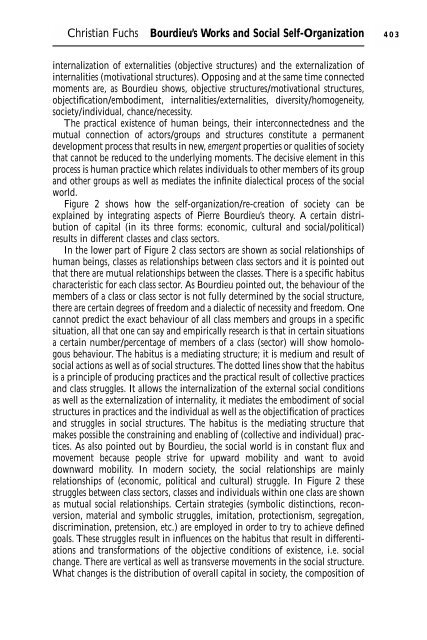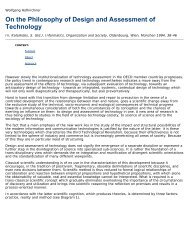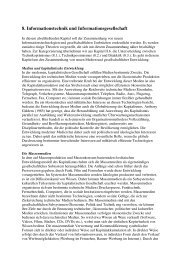Some Implications of Pierre Bourdieu's Works for a Theory of Social ...
Some Implications of Pierre Bourdieu's Works for a Theory of Social ...
Some Implications of Pierre Bourdieu's Works for a Theory of Social ...
You also want an ePaper? Increase the reach of your titles
YUMPU automatically turns print PDFs into web optimized ePapers that Google loves.
Christian Fuchs Bourdieu’s <strong>Works</strong> and <strong>Social</strong> Self-Organization 403internalization <strong>of</strong> externalities (objective structures) and the externalization <strong>of</strong>internalities (motivational structures). Opposing and at the same time connectedmoments are, as Bourdieu shows, objective structures/motivational structures,objectification/embodiment, internalities/externalities, diversity/homogeneity,society/individual, chance/necessity.The practical existence <strong>of</strong> human beings, their interconnectedness and themutual connection <strong>of</strong> actors/groups and structures constitute a permanentdevelopment process that results in new, emergent properties or qualities <strong>of</strong> societythat cannot be reduced to the underlying moments. The decisive element in thisprocess is human practice which relates individuals to other members <strong>of</strong> its groupand other groups as well as mediates the infinite dialectical process <strong>of</strong> the socialworld.Figure 2 shows how the self-organization/re-creation <strong>of</strong> society can beexplained by integrating aspects <strong>of</strong> <strong>Pierre</strong> Bourdieu’s theory. A certain distribution<strong>of</strong> capital (in its three <strong>for</strong>ms: economic, cultural and social/political)results in different classes and class sectors.In the lower part <strong>of</strong> Figure 2 class sectors are shown as social relationships <strong>of</strong>human beings, classes as relationships between class sectors and it is pointed outthat there are mutual relationships between the classes. There is a specific habituscharacteristic <strong>for</strong> each class sector. As Bourdieu pointed out, the behaviour <strong>of</strong> themembers <strong>of</strong> a class or class sector is not fully determined by the social structure,there are certain degrees <strong>of</strong> freedom and a dialectic <strong>of</strong> necessity and freedom. Onecannot predict the exact behaviour <strong>of</strong> all class members and groups in a specificsituation, all that one can say and empirically research is that in certain situationsa certain number/percentage <strong>of</strong> members <strong>of</strong> a class (sector) will show homologousbehaviour. The habitus is a mediating structure; it is medium and result <strong>of</strong>social actions as well as <strong>of</strong> social structures. The dotted lines show that the habitusis a principle <strong>of</strong> producing practices and the practical result <strong>of</strong> collective practicesand class struggles. It allows the internalization <strong>of</strong> the external social conditionsas well as the externalization <strong>of</strong> internality, it mediates the embodiment <strong>of</strong> socialstructures in practices and the individual as well as the objectification <strong>of</strong> practicesand struggles in social structures. The habitus is the mediating structure thatmakes possible the constraining and enabling <strong>of</strong> (collective and individual) practices.As also pointed out by Bourdieu, the social world is in constant flux andmovement because people strive <strong>for</strong> upward mobility and want to avoiddownward mobility. In modern society, the social relationships are mainlyrelationships <strong>of</strong> (economic, political and cultural) struggle. In Figure 2 thesestruggles between class sectors, classes and individuals within one class are shownas mutual social relationships. Certain strategies (symbolic distinctions, reconversion,material and symbolic struggles, imitation, protectionism, segregation,discrimination, pretension, etc.) are employed in order to try to achieve definedgoals. These struggles result in influences on the habitus that result in differentiationsand trans<strong>for</strong>mations <strong>of</strong> the objective conditions <strong>of</strong> existence, i.e. socialchange. There are vertical as well as transverse movements in the social structure.What changes is the distribution <strong>of</strong> overall capital in society, the composition <strong>of</strong>





